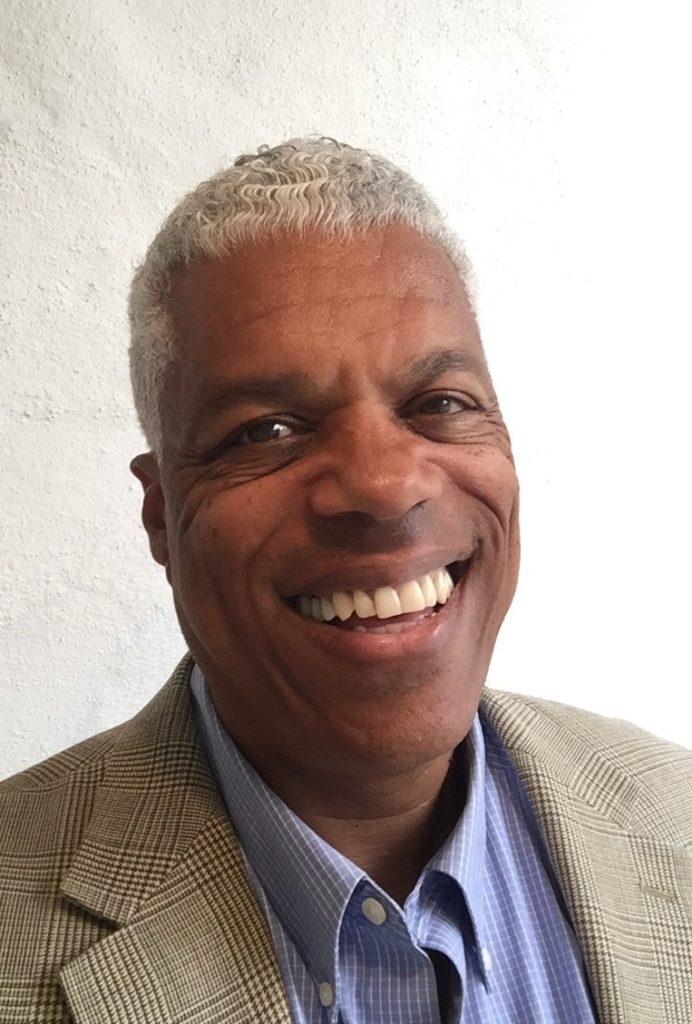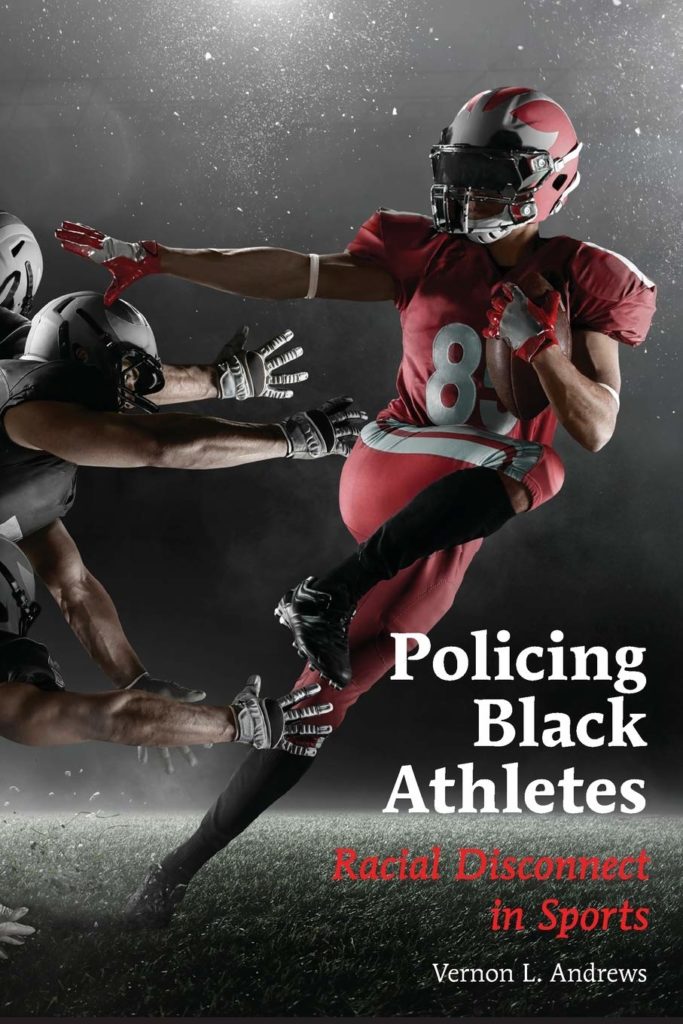
Vernon Andrews knows exactly when his long-held fascination with Black expression took hold.
As the Chico State sociology professor writes in his new book, Policing Black Athletes: Racial Disconnect in Sports, he was 12 years old and an eighth-grader in Oakland in 1972 when he wandered onto the Fremont High School campus just in time to watch the final event of a high-school track meet, the four-man 440-yard relay.
The contest pitted Fremont against arch-rival Castlemont High School, another all-Black, East Oakland sports powerhouse.
The event that changed Andrews’ life occurred during the final leg of that relay race. The Fremont quartet had held a slight edge until the baton was passed to Castlemont’s star sprinter, Karl Valrey, who quickly took the lead.
As he neared the grandstand, Andrews writes, Valrey twisted his body and ran backwards, then politely tipped his Ray-Bans to the vanquished Fremont runners and “gracefully glided past the screaming fans to victory, arms raised in forever remembered East Oakland glory.”
It wasn’t Valrey’s victory itself that elicited such a fervent fan reaction. As Andrews points out, “Crossing the finish line first was simply winning.” The crowd’s reaction was for the mastery of the moment that Valrey had demonstrated with this fully developed Black expression.
In Andrews’ words, “It was as if Jesus himself had just executed a perfect 360-degree slam dunk, such was the awe of the fans.”
Had any White people been in the crowd—Andrews saw none—they likely would not have known what to make of Valrey’s performance, but the Black fans knew: Valrey was expressing his talent and creativity before an adoring crowd, thereby claiming his freedom and power—something African-Americans have struggled to do for centuries, Andrews says, and for which they have been unjustly and maliciously penalized over and over.
Andrews cites, for example, the case of Colin Kaepernick, the former San Francisco 49ers quarterback, who was effectively banished from the National Football League for having the audacity to kneel on the sidelines during the playing of the National Anthem in protest of the mistreatment of Black people in America.
In Kaepernick’s case, Andrews explained during a recent interview at his North Chico home, Black expression took the form of social activism. Andrews notes that Kaepernick’s protest received widespread support among football players and many fans but vicious vitriol and hostility elsewhere. This was especially true among NFL owners and officials and right-wing politicians, who quickly recognized an issue that was ripe for exploitation.

Despite the threat of being permanently blackballed from the NFL, Kaepernick refused to buckle. His protest, Andrews suggests, was much like Rosa Parks’ refusal to move to the back of that Birmingham bus.
Another significant form of Black expression emerged in professional football in the 1970s, when a number of Black players began celebrating success on the field—a touchdown, an interception, a sack—by spiking the ball or doing a vivid end-zone dance.
For many years, players and owners tussled over just how much expression the NFL’s Rules Committee would allow Black athletes to have—a power struggle that continues to this day. To the members of the committee, outlawing end-zone celebrations was a matter of maintaining decorum on the playing field—that is, maintaining the kind of “sportsmanlike” behavior exhibited by White players.
In other words, Andrews writes, “[Black athletes] should not do things—like use expressive forms of behavior that are foreign to the Rules Committee—that might upset traditional White people, like those folks who impose rules on expression.”
For Andrews, it’s personal, of course. He grew up, he says, surrounded by “a large Bay Area family of roughly 80 Black cousins, aunts, uncles, nephews, nieces, and siblings that has shown me by example the complexity of everyday Black life.
“Blackness was the water I swam in for years until arriving in nearly all-White Chico” to attend its university.
For 30 years, he writes, he has been been cataloging the multiple ways White Americans study—and, yes, police—Black athletes in the desire to control them. He reminds readers of what happened to Muhammad Ali when he refused to be drafted into the Army: He was found guilty of breaking draft laws and sentenced to five years in prison. (A series of court appeals kept him free and, ironically, enabled him to become a powerful spokesman for the anti-war movement.)
After earning bachelor’s and master’s degrees from Chico State, Andrews earned a doctorate from the University of Wisconsin-Madison in 1996, after which he taught for 14 years at the University of Canterbury in Christchurch, New Zealand.
That last school was his launch pad for travels around the world, during which he studied the many ways Black people used their expressiveness to establish a sense of style that appears in nearly everything they do.
Take church, for example. It’s always been a place where Black folk feel empowered and safe, and it’s also a place that elicits stylistic creativity—in its powerful, hand-clapping gospel choirs, its preachers’ chanted call-and-response sermons and its attendees’ colorful outfits. (In his Chico home, Andrews has a display of nearly a dozen of his late mother’s gorgeous Sunday go-to-meeting hats.)
Church is just one of the many arenas in which Black people have had a profoundly enriching influence on American society. Andrews’ main interest is in the conjunction of Black expression and sports, but he’s similarly interested in Black expression as it’s manifested in music, food, clothing styles—you name it.
Policing Black Athletes is a remarkably comprehensive work filled with valuable insights into the relationship between White and Black Americans as seen primarily through the lens of sports.
Andrews, 63, worked on the book for more than 30 years. Most of that time was spent researching Black expression—its manifestations not only in the United States, but also elsewhere around the world.

He’s traveled extensively, and the more he’s learned about Black expression, its history and complexities, the more he’s wanted to know. In that time, he’s written dozens of scholarly papers while maintaining a teaching career at Chico State and San Jose State.
For Andrews and most African-Americans, it’s important to keep an open mind in dealing with White people. He tells, for example, about a night when he stopped for coffee in a Nebraska diner on his way back to graduate school in Wisconsin. When the White cashier took a long time to come up with his brew, he became suspicious, thinking that maybe the fellow was consciously ignoring him.
Then two Black men passed the counter on the way out and greeted the White cashier warmly. He answered back with a smile, addressing both of them by their nicknames.
The men were good friends, and the cashier was not a racist: “The White guy had no problems with Black people, as it turns out. As they walked out and he handed me my change, he said, ‘Sorry I took so long—I made you a fresh pot.’”
Still, the brief encounter reminded Andrews once again that “the stress of figuring out White people’s intentions takes an emotional toll [on African-Americans] even after decades of social contact.”
Author/book info: Visit drvandrews.com for more about Dr. Vernon Andrews and his writing.

Be the first to comment